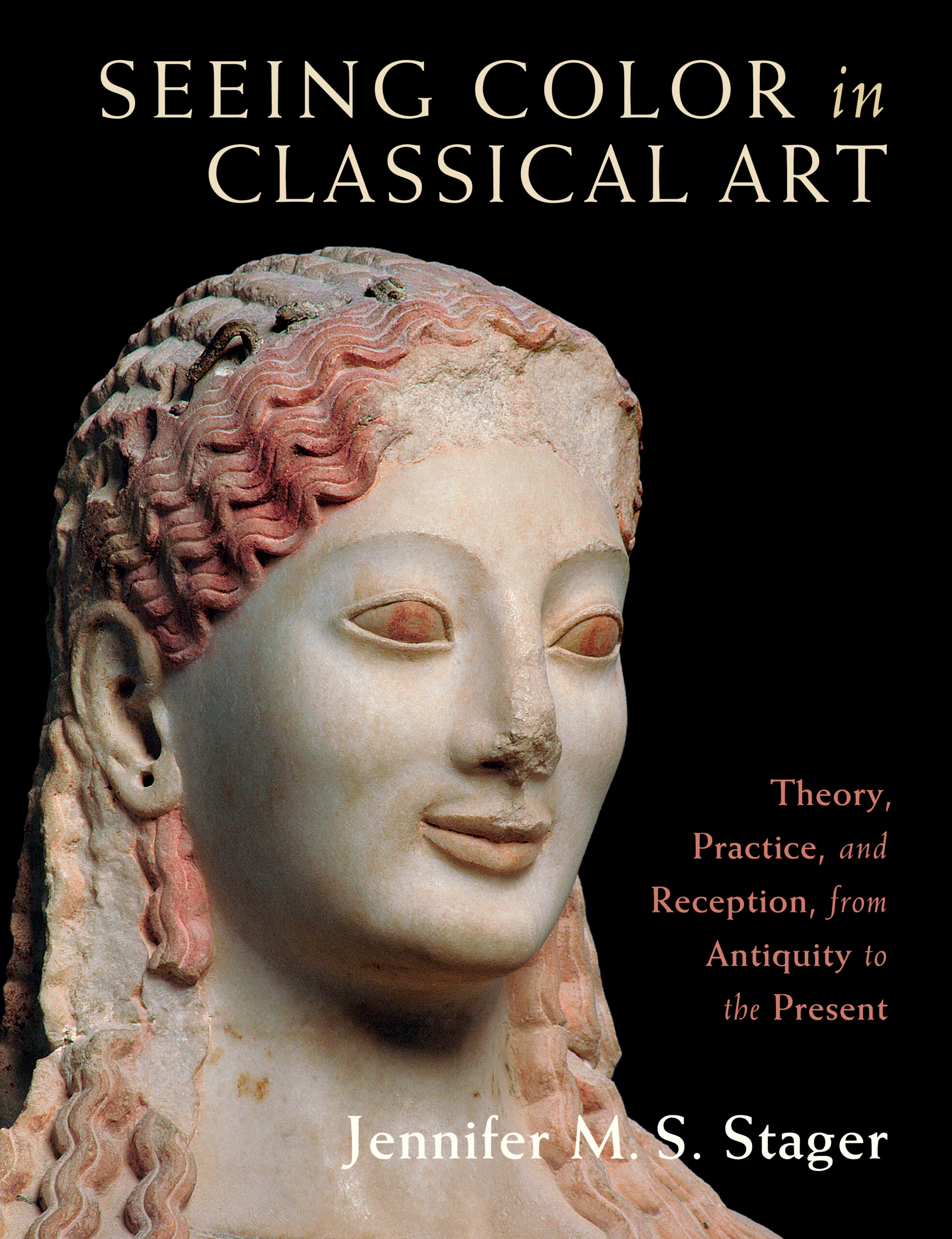
Seeing Color in Classical Art: Theory, Practice, Reception from Antiquity to the Present (CUP 2022)
An excerpt from the Introduction.
Reviews: Timothy Adelani in Journal of Classics Teaching; Seth Estrin in West 86th; Bente Kiilerich in The Classical Review.
I spoke to Professor Nandini Pandey about Seeing Color for CUP’s 1584.
Peopling the Past featured this work in the episode “Living in a Material World: Jennifer Stager and Technicolor Statues”
Related essays include:
"The Unbearable Whiteness of Whiteness" Art Practical (2018)
"The Materiality of Color in Ancient Mediterranean Art" in Essays in Global Color History: Interpreting the Ancient Spectrum ed. R. Goldman (Gorgias Press, 2016)
***
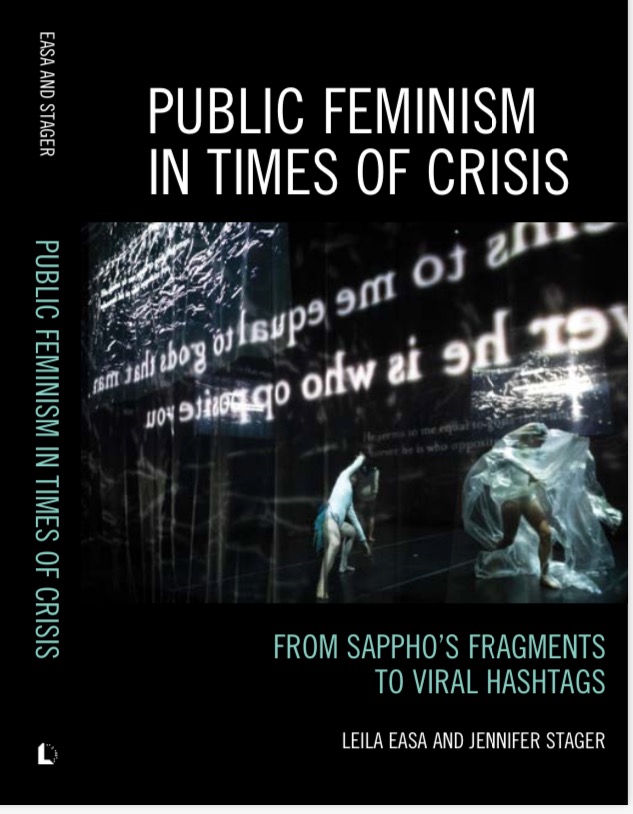
Public Feminism in Times of Crisis: From Sappho’s Fragments to Viral Hashtags (Lexington Books, 2022)
Public Feminism in Times of Crisis is a book of essays in classical receptions and feminist criticism developed in connection to ongoing political and epidemiological crises and the significant intersectional feminist response to this moment. This book examines the public practice of feminism in the age of social media and analyzes the deep histories threaded through this new(er) enactment. Six chapters analyze the Venus tradition and the archive; feminist biography and #MeToo as map; feminist translation; the collective lyric I and citational justice; virality and new materialism; and decentralized monuments and memorializing. The book’s methodology weaves together traditional academic research and public-facing media, practicing the very tools that it analyzes.
Reviews: Garcia-Ventura in BMCR; L. Mcmillan in Choice.
We are grateful to our editor Judith Lakämper at Lexington Books for permission to release this excerpt from our introduction open access:
Introduction (open access excerpts)
“In academia we often speak approvingly of the advantages of interdisciplinarity and the benefits of collaborative projects. Only rarely, however, do scholars and researchers put their money where their mouth is. For this reason Public Feminism in Times of Crisis is a rara avis, in the most positive sense of the term; it is a collaborative work written by two authors, without any noticeable differences in style or approach. What is more, the case studies cover a surprisingly wide chronology starting 30,000 years ago with the Venus of Willendorf (pp. 29-36), and reaching our days with an analysis of the #MeToo Movement and its aftermath (pp. 77-80).” -Agnès Garcia-Ventura, BMCR
An essay from this book exploring historical and contemporary list-monuments as feminist practice, “Overwriting the Monument Tradition: Lists, loss, and scale” appears in RES: Antropology and Aesthetics 75/76 (Fall 2021).
“The Matter of Gender in Ancient Greek Painting” in CHROMA: Sculpture in Color from Antiquity to Today (2025), 123-129.
“Color in Contempt” West 86th 31.2 (2025)
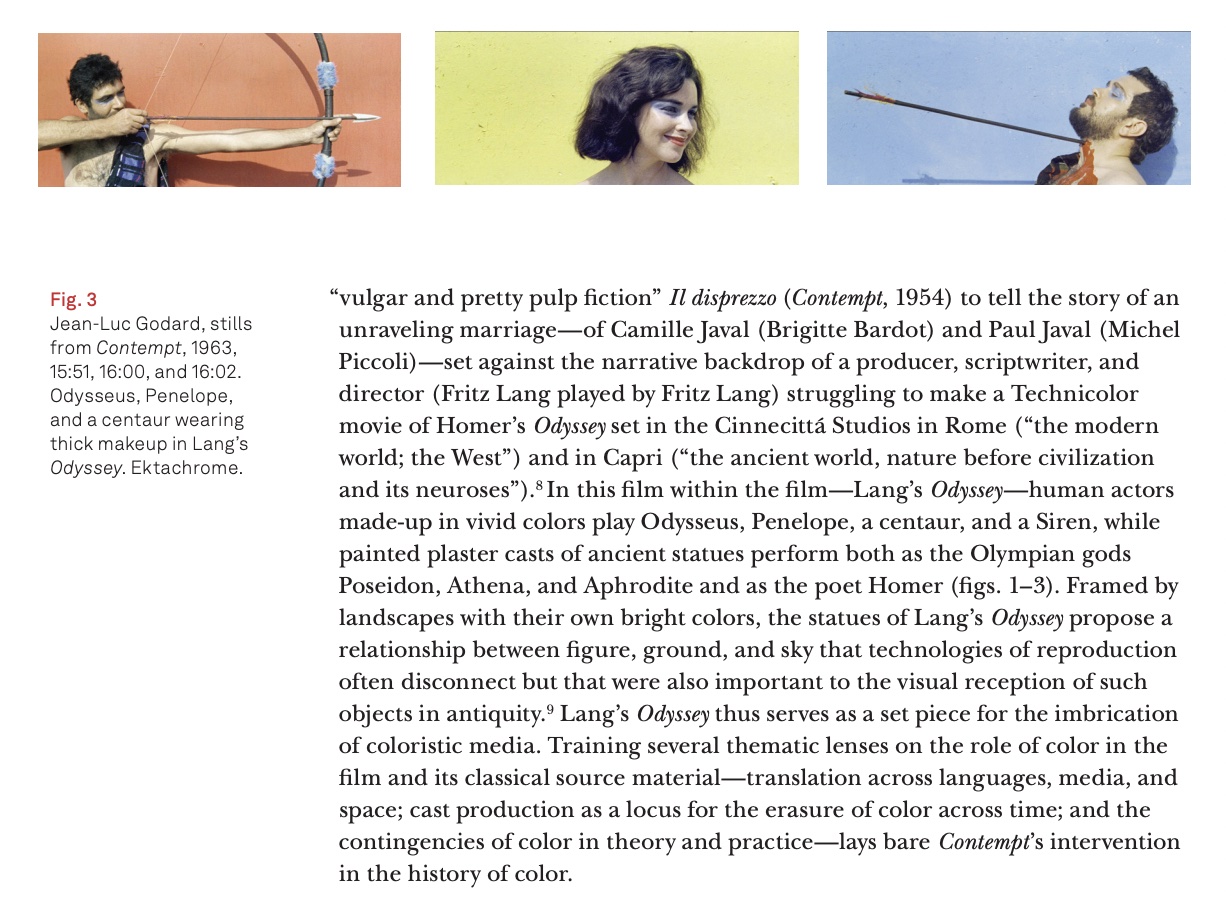
Jean-Luc Godard’s film Le mépris (Contempt, 1963) adapts Alberto Moravia’s novel Il disprezzo (Contempt, 1954) to tell the story of an unraveling marriage set against the narrative backdrop of a producer, scriptwriter, and director (Fritz Lang playing Fritz Lang) struggling to make a Technicolor movie of Homer’s Odyssey. In Lang’s mise en abyme, human actors made-up in vivid colors play Odysseus, Penelope, a centaur, and a Siren, while painted plaster casts of ancient statues perform as the Olympian gods and Homer. These painted statues intervene in long-standing debates about paint on sculpture and invoke the instability of commercial color film technologies to take aim at the fixed tradition of a monochrome classical past and the gendered, racialized associations that past had so often been designed to conjure.
“Research-Driven Pedagogy and Public-Facing Outcomes” in Ancient Pasts for Modern Audiences (with Ella Gonzalez and Danielle Ortiz).
“An Archaeology of Disability: a Dialogic Essay” Classical Antiquity 43.2 (with David Gissen, Pia Hargrove, Brooke Holmes, Pasquale Toscano, and Mantha Zarmakoupi)
An Archaeology of Disability is a research station designed for the Venice Biennale, Architettura 2021 by David Gissen, Jennifer Stager, and Mantha Zarmakoupi and exhibited later at La Gipsoteca di Arte Antica of Pisa in 2022, at the Canellopoulos Museum of Athens in 2023, and at the Archaeological Museum of Thessaloniki in 2024. The research station works with languages and forms used by contemporary disabled people to reproduce elements—a ramp, a seat, an art gallery—from the ancient Acropolis in Athens that vanished long ago and that have little or no extant material forms. Among the many people who contributed to the research station are two performers, Christopher Tester and Pia Hargrove, who performed, respectively, the ekphrastic film and audio description Sēmata (Signs) (2021). The following dialogic essay draws on conversations with the curators and performers led by Brooke Holmes and Pasquale Toscano. This dialogic form surfaces some of the collaborative aspects of the research station to highlight the ways in which such collaboration brings different lenses to antiquity.
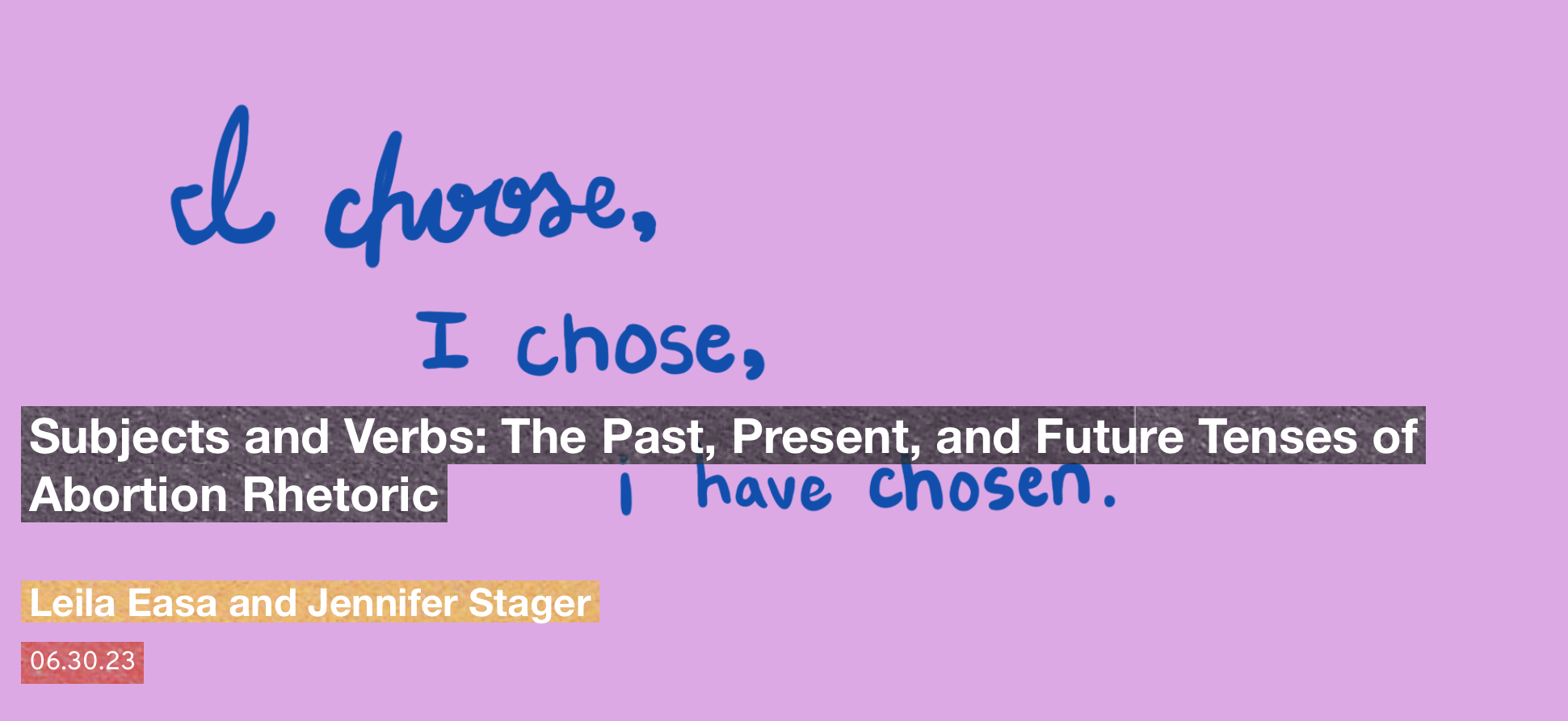 Article image for “Subjects and Verbs.” Credit: Tyler A. Tennant
Article image for “Subjects and Verbs.” Credit: Tyler A. Tennant“Subjects and Verbs: The Past, Present, and Future Tenses of Abortion Rhetoric” with Leila Easa in Abortion Now, Abortion Forever Post45 Contemporaries
Abstract: U.S. activist abortion rhetoric can be viewed as a collective abortion story that shaped both policy and epistemology around reproduction in the United States and participated in the work of nationalism. Specifically, the framework of “choice” activated by many interest groups—itself a hedge against conservative “life” rhetoric—connected abortion access to Americanness itself. Yet in contemporary discourse, new frameworks have emerged that question the capitalist and individualist underpinnings of choice, instead emphasizing relationality and continuity between the human and nonhuman. We trace the history of this shift in the context of Lena Chen’s participatory art installation, “We Lived in the Gaps Between the Stories,” which presents abortifacients and emmenagogues to (re)imagine reproductive management through an alignment with plant life. Chen’s project brings attention to ancient herbs in the present while also engaging the history of private and nonarchival practices of reproductive management that precede the nation state in modernity —the sharing of methods, materials, and treatments in networks that exist outside of legally sanctioned frameworks. Exploring such histories, practices, and materials allows us to consider an abortion story that moves beyond choice to foreground interdependence.

“Sophia’s double: photography, archaeology, and modern Greece” Classical Receptions Journal (2022) pp. 1–42.
Editor’s Choice and *open access*
In the context of the entangled productions of scientific archaeology, photographic technologies, and the Greek nation-state, this article analyses the ancient Greek idea of the eidōlon (image, phantom, double) as a paradigm for photography. Sophia Engastromenou Schliemann presented herself for the camera as Helen of Troy and mobilized an ancient textual debate about Helen and her double and the Trojan War. This image of Sophia adorned in Trojan gold is widely known and little studied and, as this essay will explore, it circulated far beyond Sophia’s control. Undergirding this article’s historical contingencies is an exploration of the photograph as eidōlon.
“Toward an Archaeology of Care” appears in Ancient Art Revisited, Carl Knappett and Christopher Watts, eds. (Routledge 2023).
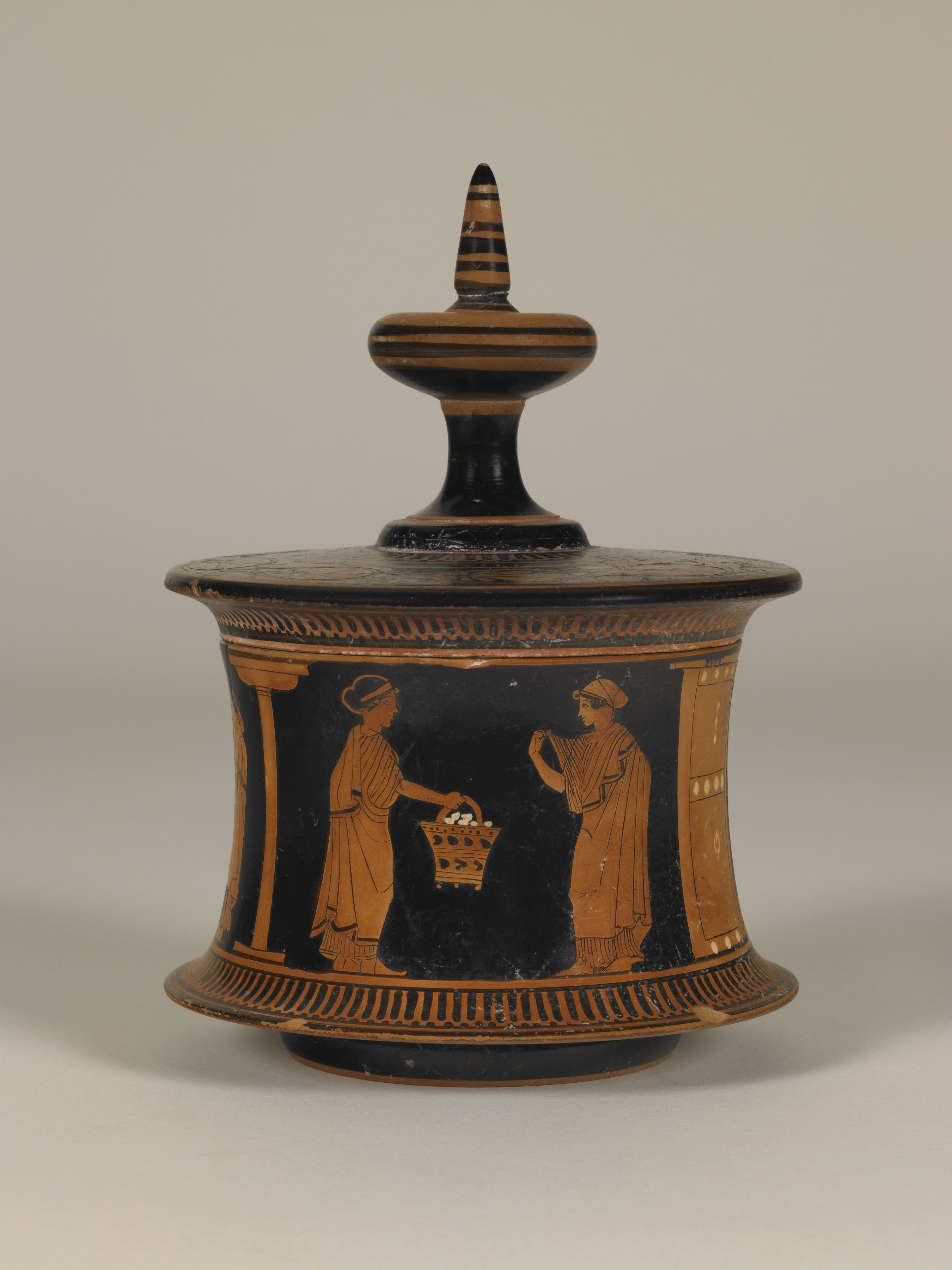
Abstract: A pyxis, or small, portable, lidded container, is an object often associated with women’s private life and personal care. Artists working in the fifth century BCE in Athens crafted a number of these containers from clay and painted them with scenes of women in community with each other. These containers offer a meso-scale at which to analyze the materialization of women’s communities of care in the ancient Greek past. Building from the philosophical framework of a feminist ethic of care to analyze this group of objects illuminates some of the networks of care undergirding ancient communities. An archaeology of care centers these networks of care and the role of careworkers and carework in forging and maintaining communities.
Reviewed in Pasts Imperfect on January 26, 2023.
“Overwriting the monument tradition: Lists, loss, and scale” RES: Anthropology and aesthetics (2021): 266-281.
Abstract: While our contemporary moment invites necessary engagement with fallism (the practice of toppling monuments of symbols of oppressive power), we wish to instead identify and narrate a parallel heritage to that of the traditional figural monument critiqued by such practices. We suggest that this parallel tradition, which runs from ancient Greece to contemporary times, can itself offer new forms of possibility to engage and include a more diverse set of voices while also remaining grounded in historical precedent. Building on Athena Kirk’s theory of apodeixis, a practice of making a list visual, “Overwriting the Monument Tradition” traces this history of apodeictic monuments from the ancient Greek casualty lists set up in Athens in the fifth century BCE to Maya Lin’s Washington, DC Vietnam memorial to the epigraphs for one thousand of the first one hundred thousand deaths from Covid-19 in the United States on the cover of the New York Times on May 24, 2020 CE to contemporary poetry, protest, and performance. Ultimately, we argue that this tradition mobilizes naming and the poetic power of the list to elevate not singular hegemony but instead a plurality of raised voices.
“Antiochene Echoes: Transformation and Representation of Narkisos and Ekhō at Daphne” Musiva & Sectilia” 18 (2021)

Abstract: This essay explores transfigurations of Narcissus and Echo in the mosaic floors excavated from the seaside town of Daphne (Harbiye) near the city of Antioch-on-the Orontes. These material and sensory transformations are particularly resonant at Daphne, a site named for the nymph who turned into a laurel tree to escape rape by the god Apollo. Of the extant examples depicting their myth at the site, only one includes a depiction of Echo in her physical form. In addition, the non-figural patterns framing these figural scenes mark Narcissus's transformation into flower, collapsing narrative time. Dispersed across different collections since their excavation in the early 20th century, this essay brings together the mosaic fragments from Daphne associated with Narcissus and Echo to analyze the imbricated artistic materializations of their metamorphoses.
“An Archaeology of Disability” with David Gissen and Mantha Zarmakoupi in Anna Anguissola and Chiara Tarantino eds. Aree archaeologiche e accessibilità: riflessioni ed esperienze, (Pisa: Pisa University Press, 2023), 19-37.
“An Archaeology of Disability” with David Gissen and Mantha Zarmakoupi in How Will We Live Together? edited by Hakim Sarkis (2021), 54-55.
“Space as Form: Sappho Now” Open Space (April 2020)
Following the performance [of extreme lyric i], artistic director Hope Mohr, writer and co-author of extreme lyric i, Maxe Crandall, and poet Dora Malech came together for a conversation on stage: “Space as Form: Sappho Now.” It is a pleasure to offer excerpts of this conversation via this space, through which we might continue nurturing our collective and collaborative Lyric I.
"The Unbearable Whiteness of Whiteness" Art Practical (2018)
Aslı Çavuşoğlu, The Place of Stone ASAP (2018)
“Devoted to the shifting valences of the color blue, Çavuşoğlu’s fresco maps transnational connections, situates ancient forms in contemporary discourse, and mines histories of pigments and materials to build up The Place of Stone from multiple loci."
On navigating academia and parenthood with Emily Wilson's Odyssey in "A Mother's Odyssey" Eidolon (Aug 31, 2018)
"The Materiality of Color in Ancient Mediterranean Art" in Essays in Global Color History: Interpreting the Ancient Spectrum ed. R. Goldman (Gorgias Press, 2016).
"Torn Bodies for Pleasure: Classicism and Monstrosity in Picasso's illustrations of Ovid's Metamorphoses" in Picasso & Rivera: Conversations Across Time (2016), is available here.
A Spanish edition of the complete catalogue and of my essay "Cuerpos destrozados por placer: clasicismo y monstruosidad en las ilustraciones de Picasso para las Metamorfosis de Ovidio", is also available.
Review of Jeremiah Barber, Alison Pebworth, and Rob Godshaw at Recology Artist-in-Residence (February 9, 2016)
“Hold On” Goop (15 Feb 2015) about navigating change in the aftermath of my husband's traumatic accident.
"Mending with Gold" in Scars: an anthology, edited by Erin Wood (2015). The book is available directly from et alia Press.
“‘Let No One Wonder at this Image” A Phoenician Funerary Stele
in Athens” Hesperia (2005): 427–449.
Abstract: An autopsy of the Hellenistic grave stele of S ˇ M[.]/.Ant.patrow , discovered in the 19th century in the Kerameikos in Athens, reveals that its textual (Phoenician and Greek) and visual components differ significantly from previously published descriptions. The author reexamines the morphology of the monument, also considering its sacred address and the force that such a monument exerted on its context. This single monument to a Phoenician buried in Athens engages issues of bilingualism, religious symbolism, and, most importantly, self-definition, which structured the complex social interactions in Athens in the late 4th–2nd centuries BCE.
ESSAY COLLECTIONS
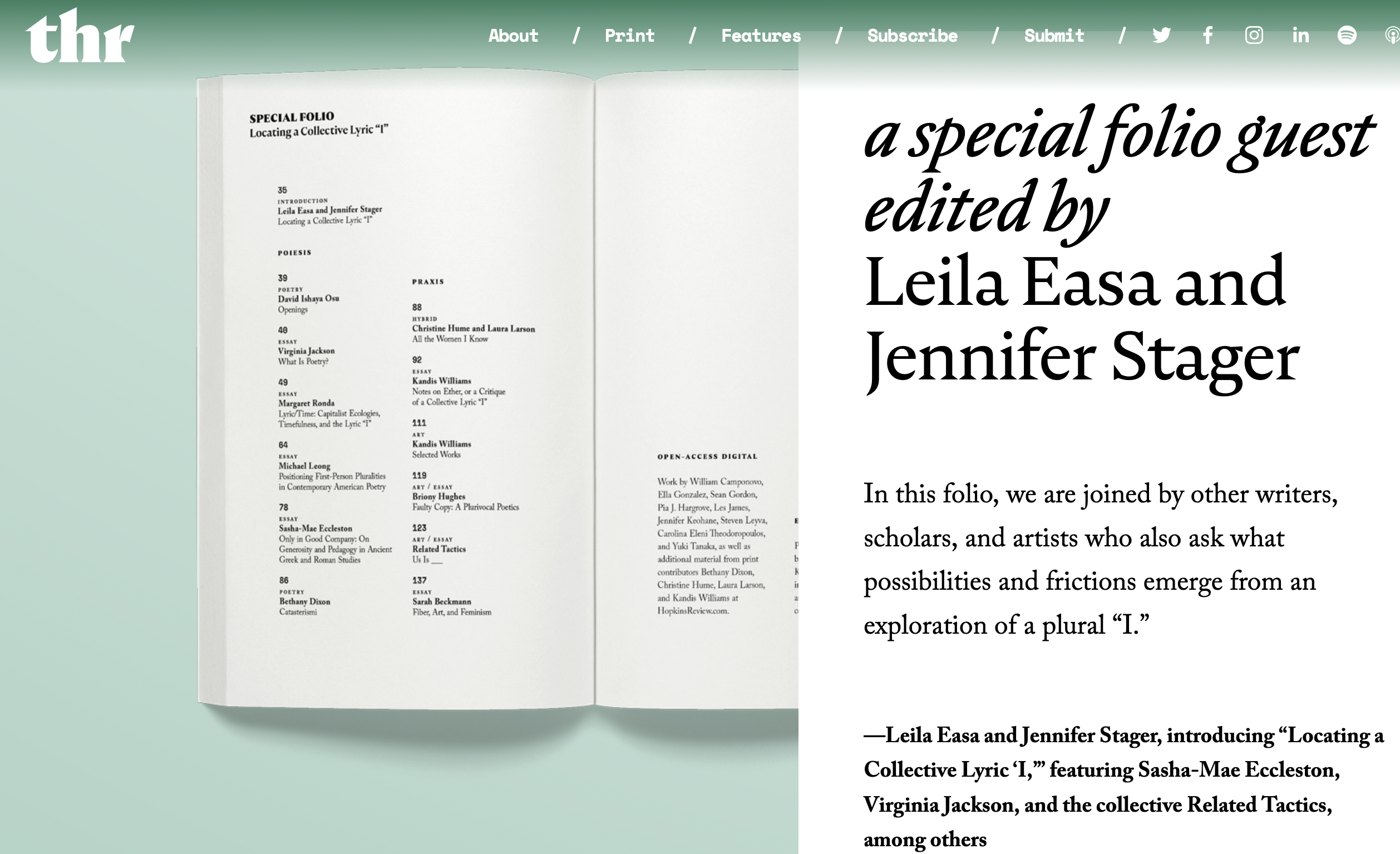
Guest-edited with Leila Easa for The Hopkins Review 17.1, “Locating a Collective Lyric ‘I’” is a special folio across devoted to the relationships and tensions between the singular and the collective as explored in poetry, visual art, and essays, among other genres.
Print: https://muse.jhu.edu/issue/52008
Digital: https://hopkinsreview.com/171-folio
Performing the Archive | Archiving Performance in The Hopkins Review (October 2023)

“Live performance always stands in some tension to its archive—the broadsheets, scripts, costumes, props, photographs, and memories that may endure after the applause has quieted—a tension that these edited transcripts both mark and perform. In addition to tracing thoughts that follow each specific performance, these conversations also mark the deep arc of the pandemic, from Baltimore’s initial shutdown to our tentative reconnections three years later.”
Bacchae Before

Open Process: Responding to anti-trans legislation through art
Tuesday, March 28th 6:15pm @Merrick Barn
Bacchae Before
Live Performances, Thursday and Friday March 30th and 31st 8pm @Merrick Barn
VITRUVIAN Baltimore takeover 27 February-02 March with two free public events!
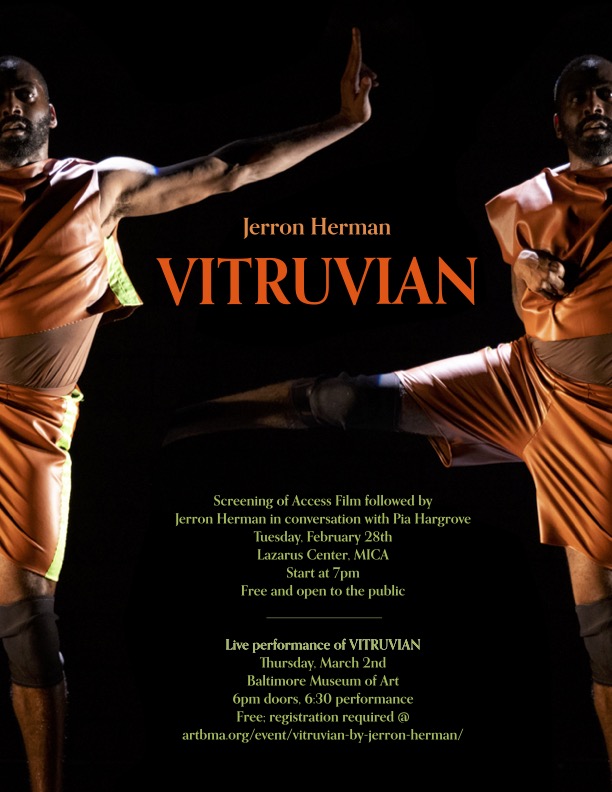
Screening of Access Film with live Talk Back with Jerron Herman & Pia Hargrove
Tuesday, February 28
7pm @MICA Lazarus Center, 131 North Ave
[Free, open to the public, ASL interpretation]
Live Performance of VITRUVIAN by Jerron Herman
Thursday, March 2
6:30pm (doors open at 6pm) @Baltimore Museum of Art
[Free, open to the public, ASL interpretation]
***
An Archaeology of Disability
(David Gissen, Jennifer Stager, Mantha Zarmakoupi) opened at the 2021 Venice Biennale Architettura: How Will We Live Together?, traveled to La Gipsoteca di Arte Antica, Pisa (Spring 2022) the Canellopoulos Museum, Athens (Summer 2023), the Archaeological Museum of Thessaloniki (Spring-Summer 2024).

Installation view, featuring three seats of stone with patterns drilled into them, the model of a ramp that vibrates when touched, photographs of the rock of the Acropolis and an older single-person elevator ascending, and a film, “Sēmata” recovering a lost Greek picture gallery that once stood at the gateway to the Acropolis, performed in Greek and American sign languages by Christopher Tester. Photo by Mantha Zarmakoupi.
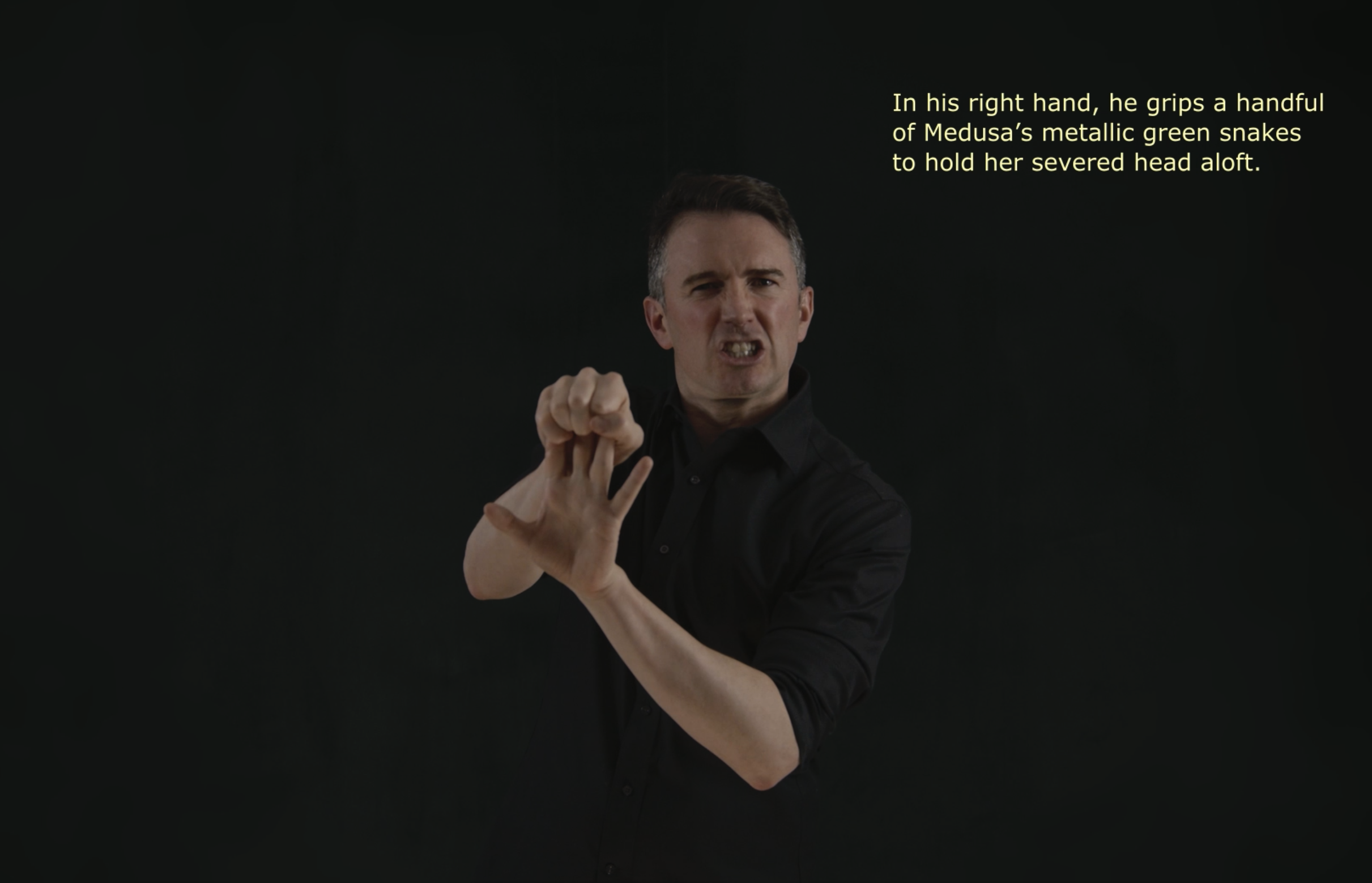
The audio description of the film, performed by Pia Hargrove, is here (https://semata.net/)
For more, see this interview on Peopling the Past about making the film-work Sēmata/Signs for An Archaeology of Disability.
And this write-up of An Archaeology of Disability in Arts & Humanities.
A range of talks took place in connection with the second stop of the research station in Pisa: Aree archeologiche e accessibilità.
Press:
https://www.unipi.it/index.php/unipieventi/event/7316-archaeology-and-accessibility-archeologia-e-accessibilita
https://www.culturenow.gr/mia-arxaiologia-tis-anapirias-ekthesi-sto-moyseio-payloy-kai-alexandras-kanellopoyloy/
***
The Antioch Recovery Project is an ongoing research lab dedicated to the study of mosaics from the city of Antioch-on-the-Orontes and its surroundings. Led by principal investigator Jennifer Stager, ARP works in collaboration with a number of scholars at Hopkins and in the Baltimore area, as well as with the global community of Antioch researchers.

Ella Gonzalez, Danielle Ortiz, and Jennifer Stager presented on ARP at the Peopling the Past Colloquium 2023
An essay related to this project “Antiochene Echoes” appears in Musiva e Sectile 18 (2021)
Hopkins Arts & Sciences magazine included a profile on this project and highlighted student work in this research-driven course.
***
Picturing Performance focuses on analyzing materials traces of performance in the ancient Mediterranean in conjunction with contemporary receptions of ancient Greek drama. Launching Spring 2023. Confirmed performances include Jerron Herman’s VITRUVIAN and Hope Mohr, Maxe Crandall, and Mike Chin’s Bacchae Before.

unexpected projects, a collaboration between Jenny Salomon Omabegho and Jennifer Stager, aims to make art more accessible to wide-ranging audiences while providing artists with a platform from which to experiment.
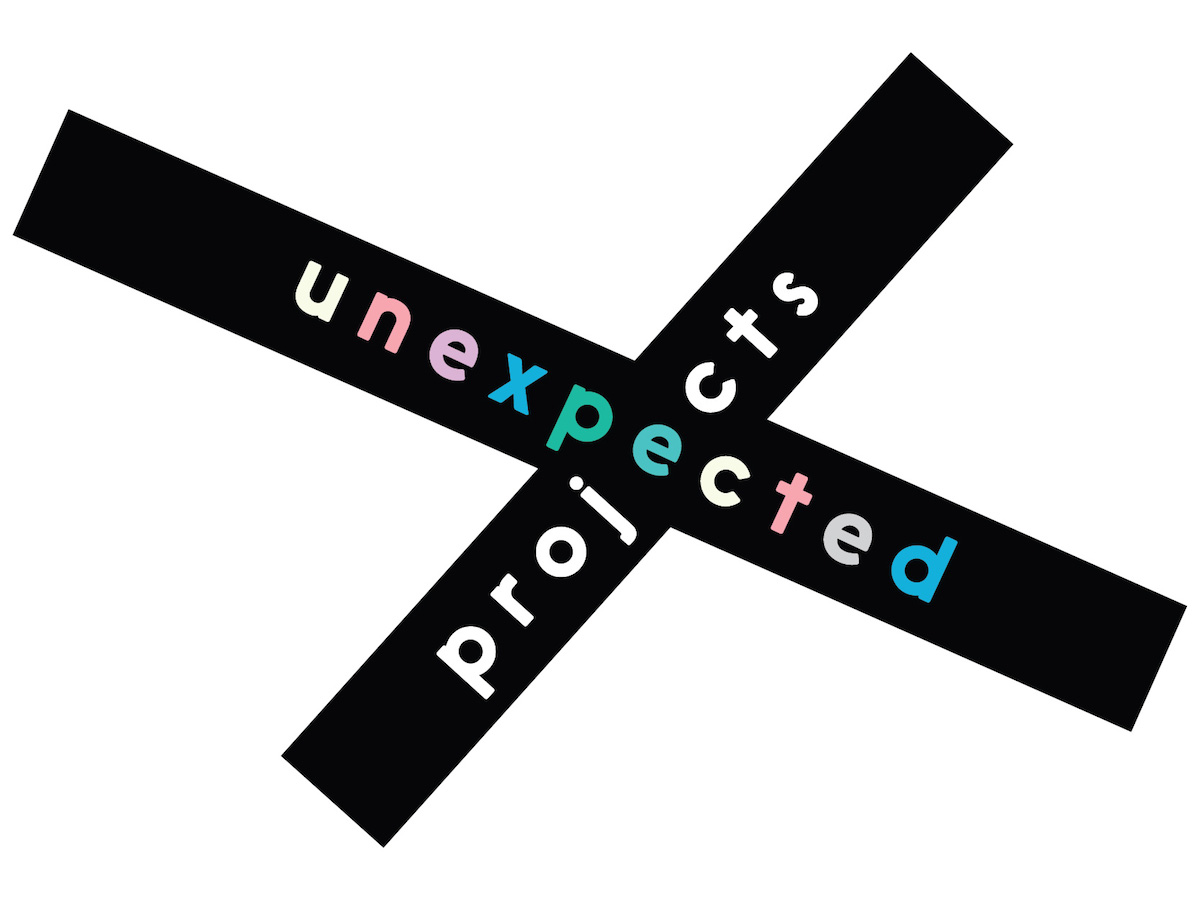
I co-curated Picasso and Rivera: Conversations Across Time at LACMA & Palacio de Bellas Artes, which won an Association of Art Museum Curators Award of Excellence in 2018. Select reviews here.
As unexpected projects, Jenny Salomon Omabegho and I produced a series of projects:
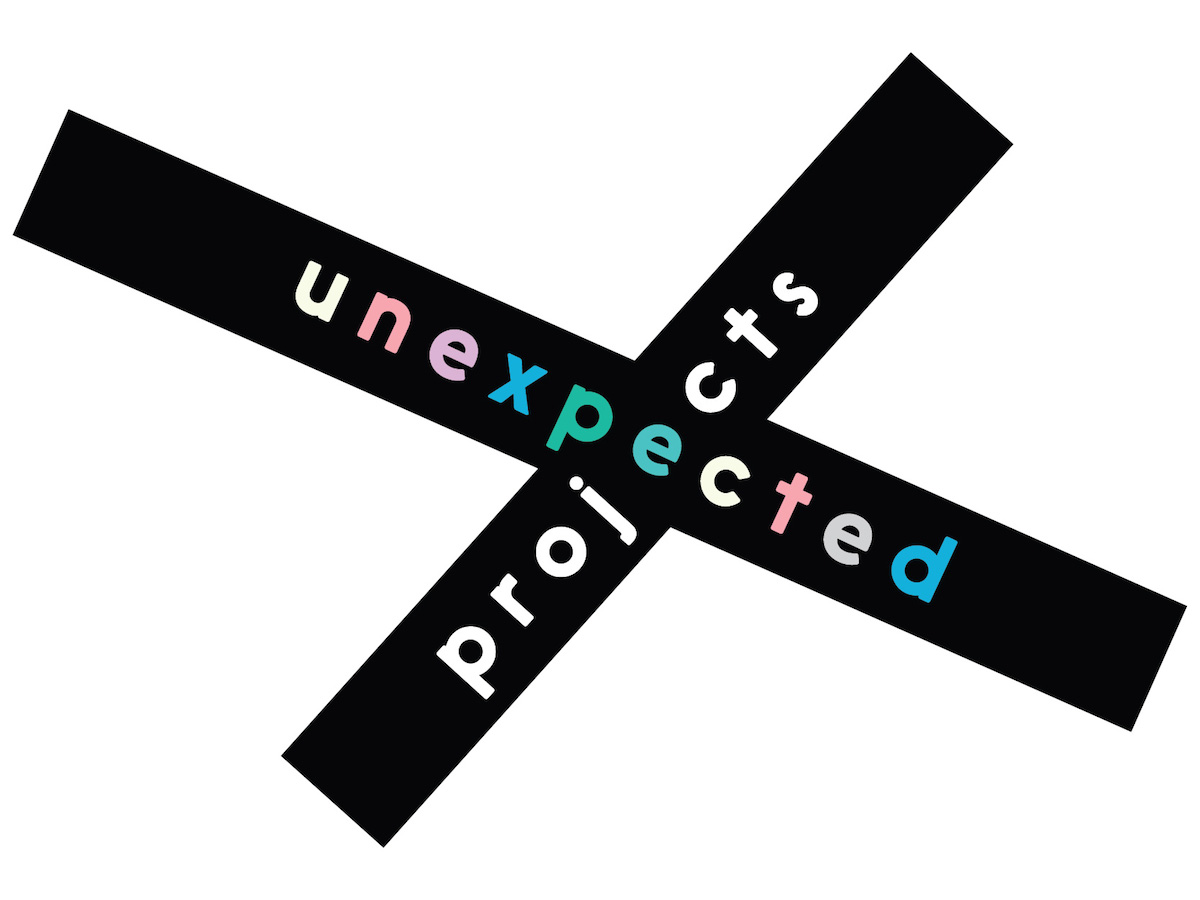 the inaugural exhibition for Artemis, including work by Renée Gertler, Bessma Khalaf, Deirdre O’Dwyer, Lisa Solomon, Jennifer Starkweather, Chris Thorson, Ali True, Liz Walsh
the inaugural exhibition for Artemis, including work by Renée Gertler, Bessma Khalaf, Deirdre O’Dwyer, Lisa Solomon, Jennifer Starkweather, Chris Thorson, Ali True, Liz Walsh 
programming for Xbus, a former prisoner-transport bus turned roving artspace, featuring Gisela Insuaste’s Haciendo marcas otra vez (and now a chapter in Kathryn Barush’s award-winning Imaging Pilgrimage, Bloomsbury 2021).

a five-part series on artistic collaboration for SFMOMA's Open Space.
1. Other-half Orbit
2. The Edge Effect
3. Objects Sublimated to Things
4. Community Property
5. Power Equals Secret Pockets
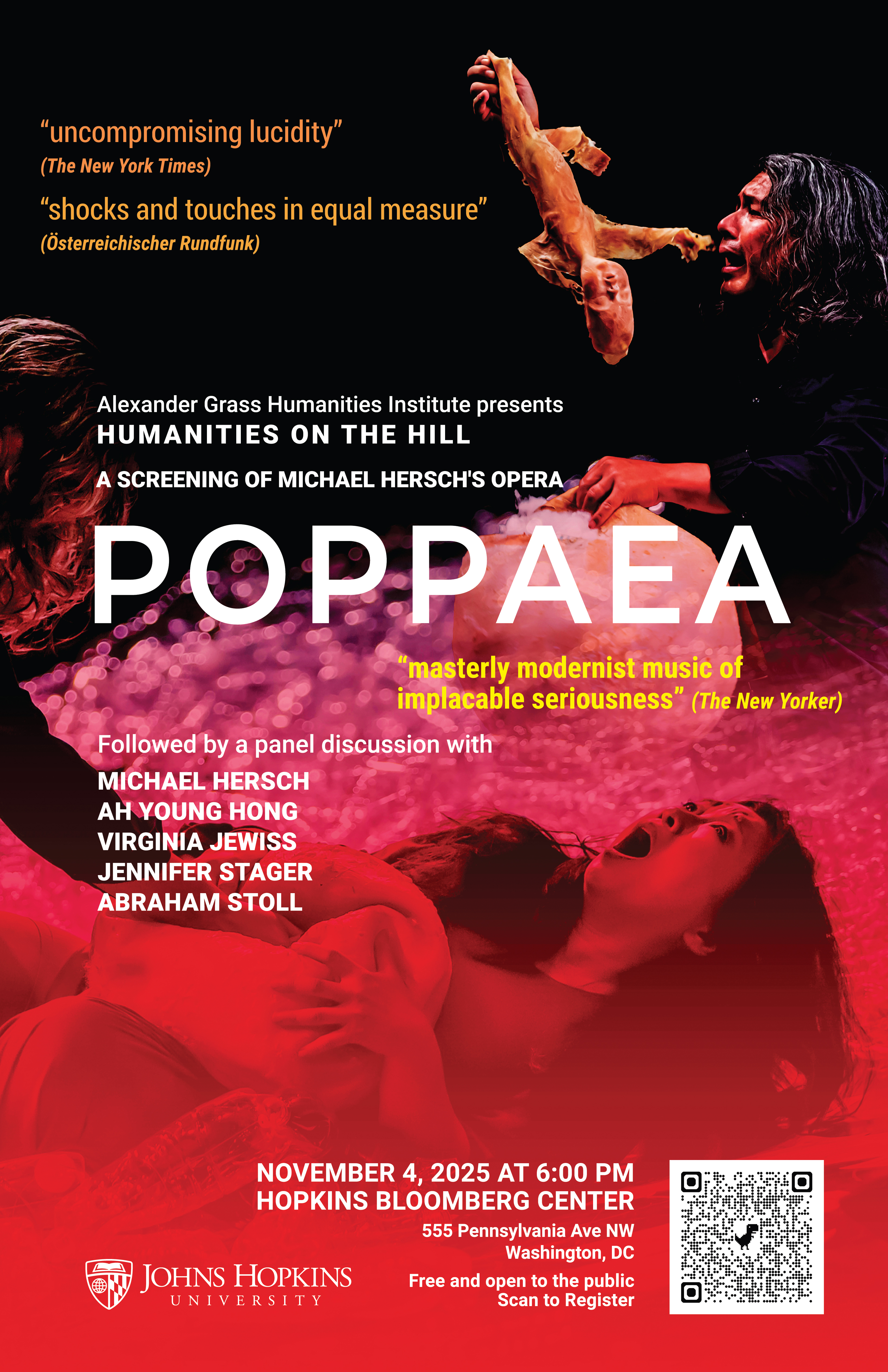
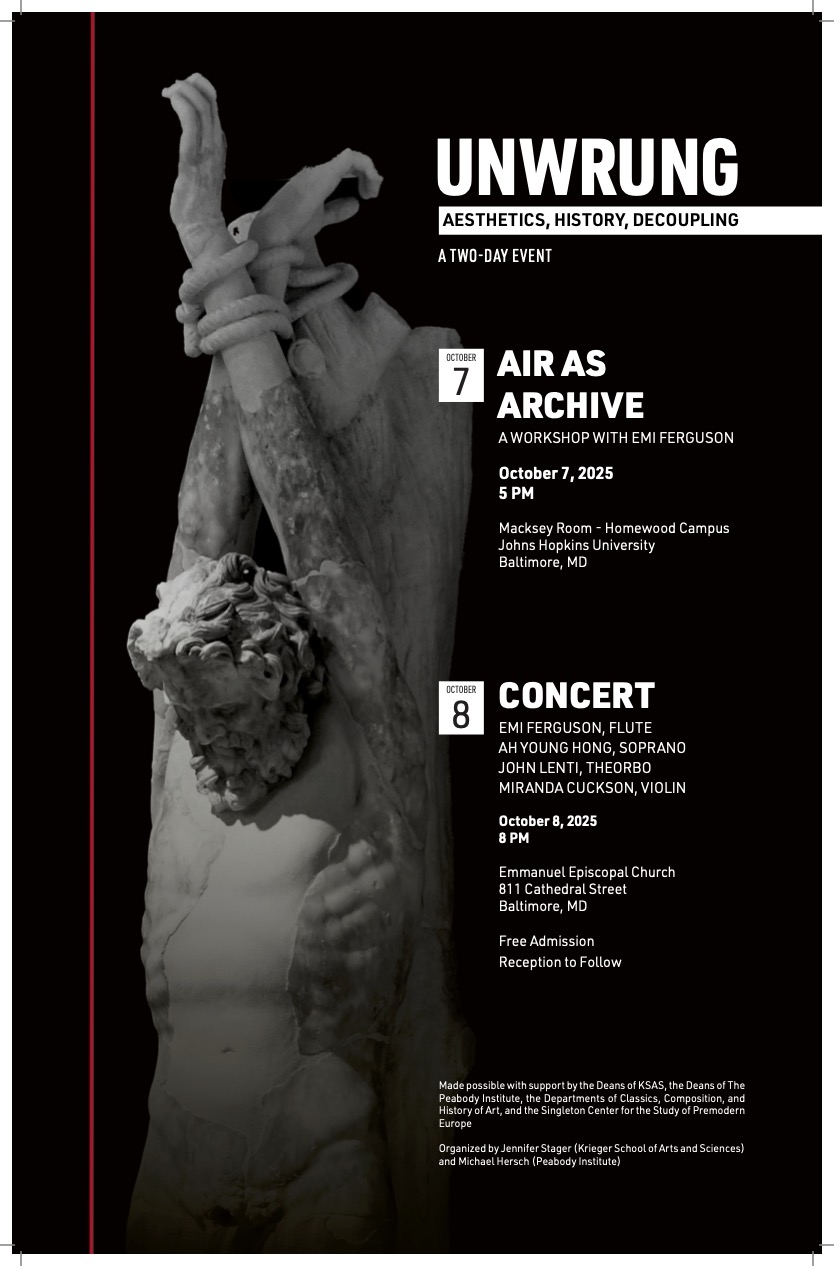
SPEAKING
27 June 2025: “Casting Knucklebones, Conducting Clouds” in Writing the Self in Art History, RAP 25 at The Clark, Williamstown, MA
01 February 2025: Collaboration, Creative Citizenship, and the Collective Lyric “I”: Join a conversation about art, activism, and collective expression across--and in--time and communities, considering the pleasures, perils, and possibilities of participating in a poetic first person plural.

27 January 2025: A conversation on the occasion of the paperback release of Public Feminism in Times of Crisis: from Sappho’s Fragments to Viral Hashtags, with Dora Malech and Leila Easa at Bird in Hand for Humanities in the Village
05 January 2025: “Modern law & ancient medicine: abortion rhetoric, plant networks, and the Supreme Court,” with Leila Easa. SCS/AIA Philadelphia
12 July 2024: “Art as Argument: Three Women | Three Receptions” Princeton Athens Center, Athens
22 May 2024: “Tracing the Tigris” Artiplaces @ TAG Santa Fe
08 April 2024: “And you: apotropaia and assemblage at Antioch” Global Approaches to Sacred Space at Stanford
March 28, 2024: Shouky Shaheen Lecture at the Lamar Dodd School of Art, University of Georgia
March 8, 2024: Daugherty Ancient World Series, Randolph-Macon College
In conversation with artist Allyson Vieira at the Corcoran on Wednesday 06Dec23 at 6:30. Tickets are free on Eventbrite.
The Sacrifice of Iphigeneia and the Paradigm of Mosaic, Piece by Piece @ Dumbarton Oaks, May 2023
Art & Abortion is a double-session convened with Leila Easa, with special respondent Dr. Mary Fissell at the Association for Art History Conference, London, 12-14 April, 2023.
The Matter of Gender, Chroma Symposium at the Metropolitan Museum of Art, March 24-25, 2023
The Antioch Recovery Project, with Ella Gonzalez and Danielle Ortiz, Peopling the Past Symposium March 25, 2023, Vancouver, CA
Accounting for Colors, The David Silberberg Lectures @IFA | NYU, March 22, 2023
“The Violence of Care: Women Enslaved as Wet Nurses in Ancient Greece” at Mother’s Milk: Breastfeeding from Metaphor to Practice (UNH and online, 21-23 October, 2023)
In 2021-2022, I served as a Kershaw lecturer for the Archaeological Institute of America
21 April 2022: “Cut from the Womb: Towards a Feminist History of Ancient Greek Medicine” Palevsky Lecture, Classics UCLA
01 April 22: Tektōn: Doctor Kits and Artist Tools, AAMW Colloquium, University of Pennsylvania
“Color and Chora” for the Program in Women, Gender, and Sexuality at Johns Hopkins.
Peopling the Past with Carolyn Laferriere and Chelsea Gardner: Living in a Material World: Jennifer Stager and Technicolor Statues
"Dragon's Blood and the Blood of Dragons" as the opening session of the Gardner Center for Asian Art's fall series Color in Asian Art: Material and Meaning.
Form Beyond the Aesthetic (a workshop)
06 March 2020 JHU & The Baltimore Museum of Art
"Marks for Words: on making from ancient Greek ekphrasis" in Languages of Art History at CAA (14 February 2020)
"Color and the Built Environment" Yale (04 Feb 2020)
“When Matter Becomes Form” New Materialism, Old Material MLA Seattle (January 2020)
"Seeing Color in Ancient Mediterranean Art: In conversation with Sarah Derbew and Susanne Ebbinghaus" Harvard Art Museums (December 2019)
“Color & Contempt” Siren Echoes: Sound, Image, and the Media of Antiquity Cornell (Nov 2019)
“Seeing Color in Ancient Mediterranean Art” Pepperdine College (October 2019)
“Color, Vision, and Variegation” University of Washington, Seattle (May 2019)
“Curatorial Practice and the Machine” Simpson Center, University of Washington, Seattle (May 2019)
“Color, keramos, and cosmos” Theoretical Archaeology Group, Syracuse (May 2019)
Sappho's Colors (Nov 11 at PAMLA)
The Power of Color in Art: Polychromy and Pigments in Ancient Mediterranean and Latin American Art
February 2nd 2018 at UC Davis; 4-7pm
Color in Classical Art
05 October 17 at the de Young Museum
Rethinking Color in Ancient Mediterranean Art
20 May 17 at the Legion of Honor Museum
Materiality in Art
08 December 16 at California College of the Arts
Picasso's Classicism
20 January 17 at Los Angeles County Museum
Living w/ Traumatic Brain Injury
03 November 16 with Peter Radavich and Dr. Phiroz Tarapore at UCSF